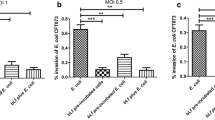Summary
Antibacterial activity of bladder mucosa is believed to be a host defense against infection. In this study we examined the antibacterial activity of the bladder mucosa without the effect of voiding. In addition we examined whether the property of adherence was advantageous for the organism in contact with the bladder mucosa. For this, three adhering and three nonadhering strains of E. coli were placed in contact with the bladder mucosa for 4 h in an in vivo rabbit model. E. coli grown in broth and applied to 32 bladders increased in titer by 1 log. E. coli grown in rabbit urine and applied to seven bladders increased in titer by 1.2 log. In contrast E. coli inoculated into control vials containing broth increased in titer by 2.3 log (P=0.01). There was no significant difference in the titer between adhering and nonadhering strains of E. coli after 4 h of contact with the bladder mucosa. Bladder mucosa may have an inhibitory effect on bacterial growth (regardless of adherence characteristics) and with urine flow serves to prevent infection of the bladder urine.
Similar content being viewed by others
References
Cobbs G, Kaye C (1967) Antibacterial mechanisms in the urinary bladder. Yale J Biol Med 40:93
Cox CE, Hinman F (1961) Experiments with induced bacteriuria, vesical emptying and bacterial growth on the mechanism of bladder defense to infection. J Urol 86:739
Eden CS, Hanson LA, Jodal U, Lindberg U, Akerlund AS (1976) Variable adherence to normal human urinary tract epithelial cells of Escherichia coli strains associated with various forms or urinary tract infection. Lancet I:490
Kallenius G, Winberg J (1978) Bacterial adherence to periurethral epithelial cells in girls prone to urinary tract infections. Lancet II:540
Kallenius G, Mollby R, Winberg J (1980) In vitro adhesion of uropathogenic Escherichia coli to human periurethral cells. Infect Immun 28:972
Kunin C (1987) Detection, prevention, and management of urinary tract infections, 4th edn. Lea & Febiger, Philadelphia, p 313
Latham RH, Stamm WE (1984) Role of fimbriated Escherichia coli in urinary tract infections in adult women: correlation with localization studies. J Infect Dis 149:835
Mulholland SG, Foster EA, Paquin AJ, Gillenwater JY (1969) The effect of rabbit vesical mucosa on bacterial growth. Invest Urol 6:593
Orndorff PE, Bloch CA (1990) The role of type 1 pili in the pathogenesis of Escherichia coli infections: a short review and some new ideas. Microb Pathog 9:75
Pere A, Nowicki B, Saxen H, Siitonen A, Korhonen TK (1987) Expression of P, type-1, and type 1 C fimbriae of Escherichia coli in the urine of patients with acute urinary tract infection. J Infect Dis 156:567
Reid G, Sobel J (1987) Bacterial adherence in the pathogenesis of urinary tract infection: a review. Rev Infect Dis 9:470
Schaeffer A, Jones J, Dunn JK (1981) Association of in vitro adherence to vaginal and buccal epithelial cells with susceptibility of women to recurrent urinary tract infections. N Engl J Med 304:1062
Snedecor GW, Cochran WG (1967) Statistical methods. Iowa State University Press, p 59
Svanborg-Eden C, Jodal U (1979) Attachment of Escherichia coli to urinary sediment epithelial cells from urinary tract infection-prone and healthy children. Infect Immun 26:837
Svanborg-Eden C, Eriksson B, Hanson LA (1977) Adhesion of Escherichia coli to human uroepithelial cells in vitro. Infect Immun 18:767
Svanborg-Eden C, Eriksson B, Hanson LA, Jodal U, Kaijser B, Janson GL, Lindberg U, Olling S (1978) Adhesion to normal human uroepithelial cells of Escherichia coli from children with various forms of urinary tract infection. J Pediatr 93:398
Virkola R, Westerlund B, Holthofer H, Parkkinen J, Kekomaki M, Korhonen TK (1988) Binding characteristics of Escherichia coli adhesins in human urinary bladder. Infect Immun 56:2615
Author information
Authors and Affiliations
Rights and permissions
About this article
Cite this article
Schlager, T.A., Lohr, J.A. & Hendley, J.O. Antibacterial activity of the bladder mucosa. Urol. Res. 21, 313–317 (1993). https://doi.org/10.1007/BF00296827
Received:
Accepted:
Issue Date:
DOI: https://doi.org/10.1007/BF00296827




